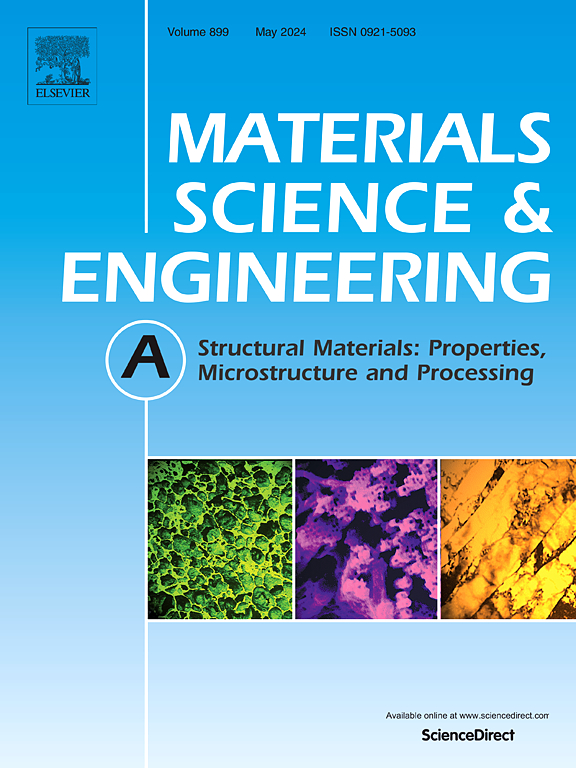HPR Al/Mg/Al复合材料多尺度界面形态演化及键合强化机制
IF 7
2区 材料科学
Q1 MATERIALS SCIENCE, MULTIDISCIPLINARY
引用次数: 0
摘要
在本研究中,我们提出了利用硬板轧制(HPR)技术制备Al/Mg/Al复合板材。此外,我们还建立了HPR复合材料板界面多尺度强化的理论框架,揭示了微米尺度波状结构与纳米尺度冶金结合之间的协同效应。对比实验表明,当Mg/Al的厚度比为2:1时,在350℃温度下,Mg/Al的厚度减少60%,显著提高了硬板的保温效果,从而通过机械联锁结构促进了界面的冶金结合。这使得扩散层的厚度增加了91.7%。电子背散射衍射(EBSD)表征表明,HPR复合材料界面晶粒分布均匀,位错密度呈梯度转变。在轧制复合过程中,热-力耦合场有利于两种金属间化合物的形成。高分辨率透射电镜(HRTEM)分析表明,Al/β- Al3Mg2和β- Al3Mg2/γ- Mg17Al12相界形成了共晶格界面,而Mg/γ- Mg17Al12相界通过半相干界面位错网络调节了晶格失配。重要的是,β/γ相界面的凹槽-碰撞结构说明了几何互锁和位错钉住的协同效应,导致HPR复合材料板的极限抗拉强度(UTS)比传统轧制样品(164.3 MPa)提高了35.9% (223.5 MPa)。此外,界面结合强度是传统轧制样品的3.8倍。本文章由计算机程序翻译,如有差异,请以英文原文为准。
Configuration evolution and bond-strengthening mechanism of multiscale interfaces in HPR Al/Mg/Al composite plates
In this study, we present the fabrication of Al/Mg/Al composite plates utilizing hard plate rolling (HPR) technology. Additionally, we have established a theoretical framework for the multiscale strengthening of the interfaces in HPR composite plates, which reveals synergistic effects between micron-scale wavy structures and nano-scale metallurgical bonding. Comparative experiments demonstrate that a 60 % reduction with a Mg/Al thickness ratio of 2:1 at 350 °C significantly enhances the thermal insulation effect of the hard plate, thereby promoting interfacial metallurgical bonding through mechanical interlocking structures. This results in a 91.7 % increase in the thickness of the diffusion layer. Electron backscatter diffraction (EBSD) characterization indicates that the interface of HPR composite plates exhibits a uniform grain distribution and a gradient transition in dislocation density. The thermal-force coupling field facilitates the formation of two types of intermetallic compounds (IMCs) during the rolling composite process. High resolution transmission electron microscopy (HRTEM) analysis reveals that the Al/β- Al3Mg2 and β- Al3Mg2/γ- Mg17Al12 phase boundaries create a common-lattice interface, while the Mg/γ- Mg17Al12 phase boundary accommodates the lattice mismatch through a semi-coherent interfacial dislocation network. Importantly, the groove-bump configuration at the β/γ phase interface illustrates the synergistic effects of geometrical interlocking and dislocation pinning, resulting in a 35.9 % increase in the ultimate tensile strength (UTS) of the HPR composite plate (223.5 MPa) compared to traditional rolled samples (164.3 MPa). Furthermore, the interfacial bonding strength is found to be 3.8 times that of the traditional rolled samples.
求助全文
通过发布文献求助,成功后即可免费获取论文全文。
去求助
来源期刊

Materials Science and Engineering: A
工程技术-材料科学:综合
CiteScore
11.50
自引率
15.60%
发文量
1811
审稿时长
31 days
期刊介绍:
Materials Science and Engineering A provides an international medium for the publication of theoretical and experimental studies related to the load-bearing capacity of materials as influenced by their basic properties, processing history, microstructure and operating environment. Appropriate submissions to Materials Science and Engineering A should include scientific and/or engineering factors which affect the microstructure - strength relationships of materials and report the changes to mechanical behavior.
 求助内容:
求助内容: 应助结果提醒方式:
应助结果提醒方式:


